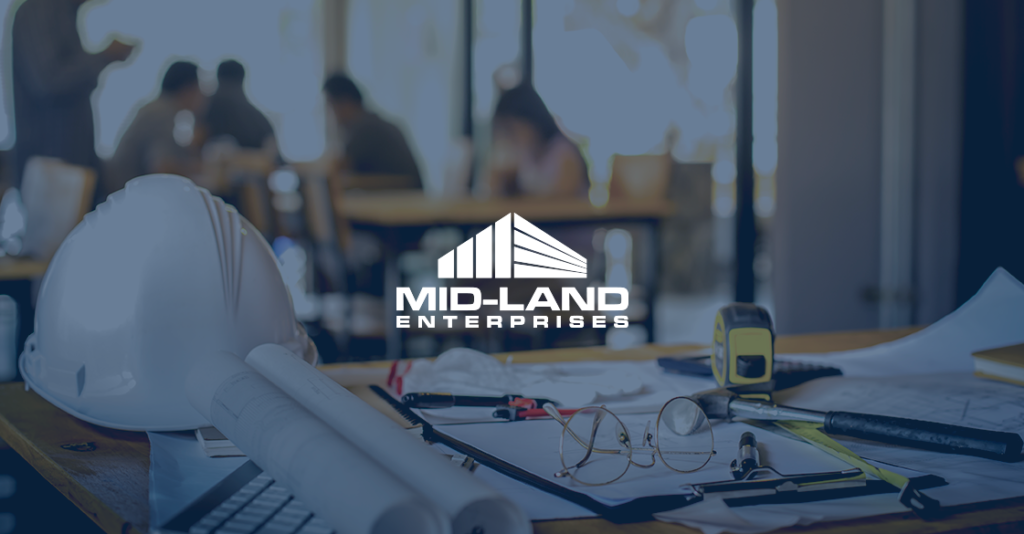Mid-Land Blog

The Basics of Workspace Ergonomics
When you think about workplace injuries, you likely think about accidents such as falls, being struck by an object, or another one of the “Fatal Four” as listed by OSHA. If you can relate to that, we aren’t surprised. It is relatively well known that these incidents are responsible for approximately 631 worker deaths every year.
But that number only represents slightly over half of the yearly fatality count. So, what are these “silent killers” – the dangers that the other 991 workers are encountering every year?
Even more concerning is that there are a staggering 892,300 annual non-fatal injuries that are considered severe and require days away from work.
Considering that 6 million workers suffer from non-fatal workplace injuries every year, what are we doing to protect ourselves from the injuries that aren’t as serious and don’t get as much attention? Let’s talk about that.
If something as simple as attention to the ergonomics of one’s workspace, can prevent lasting injuries to workers and actually boost productivity and morale, why aren’t we taking doing more to implement such measures?
Understanding Repetitive Motion Disorders
Bad workspace ergonomics can, and almost always will, lead to musculoskeletal disorders (MSDs). What is an MSD? They are injuries or disorders that affect the human body’s movement or musculoskeletal system (i.e muscles, tendons, ligaments, etc.). Some of the more common MSDs include Carpal Tunnel Syndrome, Tendonitis, or other variations of Repetitive Motion Disorders (RMDs).
RMDs are the result of repeated motions performed in the course of normal work or daily activities. And while RMDs are most common in the hands, wrists, elbows, and shoulders they can also affect other areas like the neck, back, hips, legs, knees, ankles, and feet.
RMDs are generally characterized by pain, numbness, tingling or swelling and result in the loss of flexibility and strength. People suffering from RMDs may have difficulty performing tasks that would normally be considered simple, however, over time, RMDs can cause permanent damage to soft tissues and the compression of nerve tissue.
Preventing RMDs with Ergonomics
When working a repetitive job such as construction work, working on an assembly line, or even working on a computer you run the risk of injuring yourself. And the longer you work in such a position the worse these condition will become. This is why it is so critical that employers take the necessary steps in order to prevent, or at least fight, the risk of these conditions. Something as simple as raising or lowering the height of one’s workstation can have a major effect on the overall health of an employee.
While the obvious preventative measures would be offering more frequent breaks and variation to the tasks that one performs at their job, it is understood that these things aren’t always an available option for employers. Here we list the basics of workspace ergonomics so that, if you aren’t already doing so, you can implement these measures into your working environment.
Basics of Workplace Ergonomics
Body and Working Height – Working at the wrong height leads to poor posture, which leads to a variety of other issues. Manual workspaces should be tailored to the employee. Proper workspace factors include: working height, reach zones, leg room, and range of vision
Work Area – ergonomically designed working stations prevent injury by adapting to the person working at them. Proper guidelines include: avoiding work above the heart, avoid standing still or static holding, varying physical exertion or job rotation, and minimizing exertion with roller sections and lifting aids.
Reach Zones – A well-designed workstation should be set up into three zones. Primary, Secondary, and Reference.
Range of Vision – For the optimal workstation design, it is important to address every detail, including head and eye movement.
Adjustment of Work Equipment – To maintain performance levels and promote productivity, the correct adjustment of a table, chair, footrest and position of tools and material shuttles must be easily achieved.
Better Ergonomics Leads to Better Work
By improving the ergonomics of your employee’s working environment, you improve the lives of your employees. Clearly, this personal benefit is enough to make you want to make any necessary changes to your workspaces, but remember, by doing so you also help your company’s bottom line.
Better workspaces make your employees more comfortable allowing them to work for longer periods before fatigue. More comfortable work environments also lead to an increase in employee morale which in turn leads to better retention and less turnover. Lastly, better ergonomics in an employee’s workspace allows for more productivity which is an obvious benefit for any employer.
Take the time to inspect your workstations and complete the necessary changes to make them as ergonomic as possible. Your employees will thank you.
While we understand that each job site and workspace if different that’s why we developed our the 5S Workplace oOrganization Methodology – So you can keep your site cleaner and your employees safer. Download our FREE 5S Guide to Workplace Organization today!